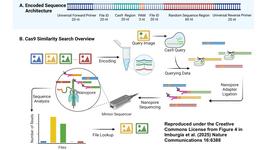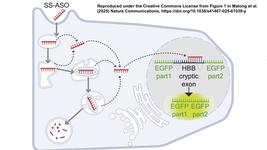Carbon
CARBON Newsletter (17 May) - Your Latest News About CRISPR in AgroBio
By: Gorm Palmgren - May. 17, 2022
CRISPR AgroBio News (CARBON) is a new initiative from CRISPR Medicine News. CARBON will bring you the latest news on how CRISPR can shape agriculture for the future to guarantee food security in times of population growth and climate change.
To get more CRISPR AgroBio News delivered to your inbox, sign up to the free weekly CARBON Newsletter here.
Top picks
- CRISPR-Cas9 has been used in lettuce (Lactuca sativa) to delay bolting, i.e., when crops put on a vertical growth spurt to flower and set seed before the vegetables are ready for harvest. To achieve the late-flowering and late-bolting phenotypes, the Chinese researchers introduced a single base mutation in SOC1, a transcription factor that regulates flowering time.
- Researchers in the UK and the Czech Republic have shown that DNA methylation can alter CRISPR-Cas9 editing frequency and DNA repair outcome in a target-specific manner. The team used Nicotiana benthamiana to demonstrate that high levels of promoter cytosine methylation, but not gene-body methylation, decreased the frequency of Cas9-mediated mutations. Moreover, DNA methylation also influenced the ratio of insertions and deletions and potentially the type of Cas9 cleavage in a target-specific manner.
Disease control
- Researchers in China have demonstrated a way to develop plants with resistance against Phytophthora parasitica through the knockout of a microRNA (miRNA). The researchers used CRISPR and other tools to show that overexpression of the gene core-2/I-branching beta-1,6-N-acetylglucosaminyltransferase (AtC2GnT) increases resistance in Arabidopsis thaliana. Moreover, they showed that the miRNA miR398b suppresses the expression of AtC2GnT, suggesting that CRISPR knockout of miR398b might lead to Phytophthora resistance.
Nutritional quality
- Spanish researchers have used the multiplexable CRISPR activator dCasEV2.1 for re-routing metabolic fluxes towards the accumulation of metabolites of interest. After careful selection of target genes and guide RNAs combinations, the scientists were able to enrich Nicotiana benthamiana leaves of four different flavonoids by activating three to seven genes in each metabolic pathway. Individual gene activation levels ranged from 4- to 1500-fold.
Agronomic traits
- Researchers in Ethiopia and the USA have used CRISPR-Cas9 to develop tef (Eragrostis tef), an important staple food in Ethiopia, with significantly higher resistance to lodging. The feat was achieved by introducing knockout mutations in the tef orthologue of the rice SEMIDWARF-1 (SD-1) gene. It is the first demonstration of genetic transformation and CRISPR-Cas9-mediated genome editing in this highly valuable but neglected crop.
- Self-incompatibility (SI) is a common trait in Chinese cabbage (Brassica rapa ssp. pekinensis) that limits breeding programmes. Researchers in South Korea have now used CRISPR to indirectly knock out the function of type 2A serine/threonine protein phosphatase (PP2A) that controls SI. This was achieved by knocking out the PP2A 55 kDa B regulatory subunit (PR55/B) gene that controls PP2A. As a result, gene-edited plants were self-compatible and might be helpful for future breeding of Chinese cabbage.
- Researchers in China have used CRISPR-Cas9 to develop male-sterile tomato (Solanum lycopersicum) that can be useful in future breeding programmes. The feat was achieved by knockout of the gene ABORTED MICROSPORES (SlAMS) which is essential for tapetum development, and this resulted in an 89% reduction of pollen viability.
Industry
- The recent cooperation agreement between the Israelian startup BetterSeeds and Merck/MilliporeSigma is the subject of a write-up in the Times of Israel. Executives from both these two and other companies express their views on how CRISPR gene editing can help farmers satisfy the rising demand for food.
- The €480 billion cosmetics industry is looking for greener ingredients, and CRISPR might be part of the solution. In a write-up on Labiotech, Jon Kratochvil at ERS Genomics suggests that the gene-editing technology can be used for the large-scale production of plant-based ingredients like squalane that comes from sharks.
Regulation and opinion
- A piece in The Guardian discusses the forthcoming UK genetic technology (precision breeding) bill that will liberate the commercialisation of gene-edited crops. The legislation has been welcomed by leading UK biologists, though they also point out that more public debate about the issues involved is needed.
- In an interview with Next Nature Network, John van der Oost from Wageningen University, the Netherlands, speak about how the CRISPR-Cas system can be used for assisted evolution. Among other topics, he looks at the possibilities in agriculture and discusses how the technology can influence biodiversity.
Reviews
- A review by Czech and German researchers summarises how CRISPR-based genome editing can improve the root system architecture to enhance crop production genetically. The authors note that below ground components have hitherto only been given limited attention, and they suggest future research directions involving the knowledge of the root system architecture in cereals.
- In a review, researchers from India summarise various applications of the CRISPR-Cas system and its prospects in plant biotechnology, targeting crop improvement with a higher yield, disease tolerance and enhanced nutritional value.
- Researchers from China look at how rice endosperm could be modified by gene editing or genetic engineering to design metabolic pathways and express and store stable products. The review also explores the use of molecular farming, from producing medicines to developing functional food crops. Finally, it discusses the factors restricting the commercialisation of transgenic rice products and prospects.
- The interaction between Xanthomonas and host plants involves transcription activator-like effectors (TALEs) secreted by the pathogen and translocated into host cells to manipulate the expression of target genes. A Chinese review summarises the progress of studies on this interaction and discusses how it relates to the gene-editing tool TALEN.
Tags
CLINICAL TRIALS
IND Enabling
Phase I
Phase II
Phase III
Recurrent or Progressive High-grade Glioma, (NCT06737146)
Sponsors:
Suzhou Maximum Bio-tech Co., Ltd.
Sponsors:
Suzhou Maximum Bio-tech Co., Ltd.
IND Enabling
Phase I
Phase II
Phase III
Advanced Peritoneal Malignancies or Abdominal Metastatic Solid Tumors, (NCT06912152)
Sponsors:
Zhejiang University
Sponsors:
Zhejiang University
IND Enabling
Phase I
Phase II
Phase III







